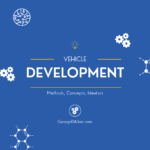Utilization of the Usecase – Deep dive: New Technology Development

Utilization of the Usecase
Specific Usecase Example: Development of the Occupant Sensing System functions
Beginning with the example of the Usecase in order to assess the scope of work necessary for the development of the Technology (set), which would be capable of the totality of the Occupant Sensing functions necessary for the Passive Safety.
Continuing with a simple script: Imagine a person approaches the vehicle. Coming with a slow speed the potential occupant enters the field of view. Then, opens the driver’s door and sits into the driver’s seat. The vehicle is stationary with the power off.
Furthermore, the following discussion shows the potential assessment for the facets of the Technology development to facilitate the vehicle level functionality for this example.
Unlocking Vehicle Safety (fully developed) Functions (capability and performance): Essentials of the working with a given Usecase
Consequently, utilizing the holistic systems approach for the Usecase utilization, let’s assume a completely developed capability to perform for the Passive Safety governing features.
Further, as the alive object approaches the proximity of the sensors’ field of view, the power for the sensor needs to be either available or initiated. Right after that the Data Acquisition begins. Since all of the requirements are already known for this fully functional technology, the data acquisition and processing take place continually. Additionally, the completion of each requirement is achieved, when analysis shows that the processed data set is equivalent to the criteria.
Sequentially, the initial functional requirement is the recognition of the moving object (in size) and reaching the specific proximity (location) – distance before the vehicle exterior. Continuing, once the system’s processor computes completion of the specific criteria set, it sends the signal to the Vehicle Processing ECU via interface – (Vehicle Intrusion / Safe Entry Feature).
Finally, once the door is open and the alive object enters the vehicle interior, the Occupant’s Presence and immediate approximate Location signals are to be generated and provided. The status of alive presence and count should be known and available for the interfaces until the person leaves the interior (boundary condition – vehicle interior). The occupant’s location based on the position of the body related to the vehicle seating map is to be approximated at any time, then verified once the body stop moving within the interior.
Usecase Example: Comments on the intended Signals Output
Continuing with an example, once the Occupant – Driver is finally seated, all of the system processing related to the Detection, Location, and even Classification functions can be completed. The result of this is the following signal set: Alive Occupant, Count=1, Located in the driver’s seat, Driver by default. (Specific classification requirements are covered separately)
References:
- Governing Features https://georgedallen.com/development-of-the-prerequisites-new-passive-safety-features/
- Occupant Presence Detection https://georgedallen.com/develop-presence-detection-new-occupant-sensing-tech/
- Occupant Location https://georgedallen.com/develop-occupant-location-new-sensing-tech/
- Basic Classification https://georgedallen.com/develop-the-core-of-occupant-classification-new-sensing-tech/
- Classification – Stratification covered separately later
Additional Content to account for in the Usecase:
Following the general overview related to the Prerequisites, it’s crucial to delve deeper into the specifics for each Usecase. In addition to understanding Alive Object behavior, meticulous attention must be given to various aspects. Sequentially, this includes assessing Power availability, monitoring Vehicle Status conditions, and keeping track of the status of doors and windows. Moreover, adapting to specific environmental conditions such as light intensity, moisture levels, and temperature fluctuations is imperative for optimal performance. Furthermore, engineers must account for potential external influences like magnetic fluctuations or vibrations caused by outside sources. Finally, by considering these factors comprehensively within each Usecase, vehicle systems is to be engineered to meet diverse requirements effectively.
Comments: Potential AI and Virtualization Application – Development of the Usecase
In addition, exploring the potential application of AI and Virtualization, it’s essential to build upon the concepts outlined above. Sequentially, the system can develop action scripts by combining occupant behavior with various environmental conditions.
Consequently, the creation of a specific Total Usecase entails integrating logic for the defined system sensors and processors activities. The Total Usecase is defined as a comprehensive script and logic encompassing alive object behavior within the vehicle’s scope, coupled with environmental variations and system logic necessary for generating Signal Output associated with specific Vehicle Feature Functions.
Moreover, achieving this level of sophistication for the Feature level requirement necessitates leveraging AI tools. Additionally, the complexity of simulations required for development and evaluation can be facilitated through virtualization/modeling and the utilization of AI tools.
Finally, by adopting these methodologies, the development of the Usecase can be streamlined, ensuring efficiency and effectiveness in system engineering for vehicle applications.
Conclusion - the Development of the Technology for the Usecase
In conclusion, summarizing the approach to address an example Usecase, the technology set, which is a combination of the mechanical, electrical and software elements, should account for:
- All of the necessary prerequisites – see prerequisites link, such as sensor (s) placement / interface and the Field of View, etc.
- Define the system’s logic for the data acquisition and processing
- Develop all of the requirements from the power initiation, data acquisition, etc., through the interfaces where the signal outputs are sent
- Have the capability to keep the last know Signal Out (set) as long as necessary
- Be capable to go to sleep, when the function is complete and reinitiate upon the change of the conditions, when necessary
- Etc.
References:
Virtual Development: https://georgedallen.com/virtual-development-embracing-tomorrow-today/
“Virtualization” definition: https://en.wikipedia.org/wiki/Virtualization
About George D. Allen Consulting:
George D. Allen Consulting is a pioneering force in driving engineering excellence and innovation within the automotive industry. Led by George D. Allen, a seasoned engineering specialist with an illustrious background in occupant safety and systems development, the company is committed to revolutionizing engineering practices for businesses on the cusp of automotive technology. With a proven track record, tailored solutions, and an unwavering commitment to staying ahead of industry trends, George D. Allen Consulting partners with organizations to create a safer, smarter, and more innovative future. For more information, visit www.GeorgeDAllen.com.
Contact:
Website: www.GeorgeDAllen.com
Email: inquiry@GeorgeDAllen.com
Phone: 248-509-4188
Unlock your engineering potential today. Connect with us for a consultation.

